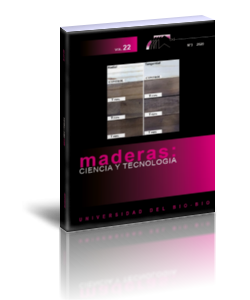Dimensional stability and colour responses of Pinus elliottii wood subjected to furfurylation treatments
Keywords:
CIELAB, anisotropy, dimensional stability, furfuryl alcohol, colourimetryAbstract
Organic substances have been used for different wood treatments, especially impregnation procedures, aiming to improve certain wood properties. The objective of this study was to evaluate dimensional stability and colorimetric features for a mature pine wood (Pinus elliottii) impregnated by vacuum-pressure process with variable concentrations (10 wt%, 25 wt% and 50 wt%) of furfuryl alcohol (using ethyl alcohol as catalyst). The wood samples were characterized for: linear shrinkages, linear swellings, shrinkage anisotropy, swelling anisotropy, as well as colorimetric parameters (following the CIELab method). The impregnation with furfuryl alcohol increased the dimensional stability of the studied pine wood and the treatment with 50 wt% of furfuryl alcohol stood out based on these results. Regarding the colour patterns, there were changes in the final colorimetric appearances of the treated wood samples, which acquired darker and reddish colours when compared to the pristine group. The treatment with 50 wt% furfuryl alcohol again was responsible for the highest colour change and, because of that, may be indicated for solid wood products with high added value.
Downloads
References
Bao, F.C.; Jiang, Z.H.; Jiang, X.M.; Lu, X.X.; Luo, X.Q.; Zhang, S.Y. 2001. Differences in wood properties between juvenile wood and mature wood in 10 species grown in China. Wood Sci Technol 35(4): 363-375. http://dx.doi.org/10.1007/s002260100099
Dong, Y.; Qin, Y.; Wang, K.; Yan, Y.; Zhang, S.; Li, J.; Zhang, S. 2016. Assessment of the performance of furfurylated wood and acetylated wood: comparison among four fast-growing wood species. BioResources 11(2): 3679-3690. http://dx.doi.org/10.15376/biores.11.2.3679-3690
Ermeydan, M.A.; Cabane, E.; Gierlinger, N.; Koetz, J.; Burgert, I. 2014. Improvement of wood material properties via in situ polymerization of styrene into tosylated cell walls. Rsc Adv 4(25): 12981-12988. http://dx.doi.org/10.1039/C4RA00741G
Esteves, B.; Nunes, L.; Pereira, H. 2011. Properties of furfurylated wood (Pinus pinaster). Eur J Wood Wood Prod 69(4): 521-525. http://dx.doi.org/10.1007/s00107-010-0480-4
Gérardin, P. 2016. New alternatives for wood preservation based on thermal and chemical modification of wood – A review. Ann For Sci 73: 559-570. http://dx.doi.org/10.1007/s13595-015-0531-4
Lande, S.; Westin, M.; Schneider M.H. 2004. Properties of furfurylated wood. Scand J For Res 19(5): 22-30. https://doi.org/10.1080/0282758041001915
Magalhães, W.L.E.; Da Silva, R.R. 2004. Treatment of Caribbean pine by in situ polymerization of styrene and furfuryl alcohol. J Appl Polym Sci 91(3): 1763-1769. https://doi.org/10.1002/app.13252
Mantanis, G.I. 2017. Chemical modification of wood by acetylation or furfurylation: A review of the present scaled-up Technologies. BioResources.12 (2): 4478-4489. https://doi.org/10.15376/biores.12.2.Mantanis
Mantanis, G.; Lykidis, C. 2015. Evaluation of weathering of furfurylated wood decks after a 3-year outdoor exposure in Greece. Drvna Ind 66(2): 115-122. https://doi.org/10.5552/drind.2015.1425
Mori, C.L.S.O.; Lima, J.T.; Akira Mori, F.; Trugilho, P.F.; Goncalez, J.C. 2005. Caracterização da cor da madeira de clones de híbridos de Eucalyptus spp. Cerne 11(2): 137-146. https://www.redalyc.org/pdf/744/74411204.pdf
Pincelli, S.M.; Piedade, A.L.; De Moura, L.F.; Brito, J.O. 2012. Effect of thermal rectification on colors of Eucalyptus saligna and Pinus caribaea woods. Maderas-Cienc Tecnol 14(2): 239-248. http://dx.doi.org/10.4067/S0718-221X2012000200010
Schneider, P.R.; Elesbão; L.E.G., Schneider, P.S.P.; Longhi, R.V. 2014. Crescimento em diâmetro do Pinus elliottii e Pinus taeda em áreas arenizadas e degradadas no Oeste do Rio Grande do Sul. Cienc Rural 44(9): 1561-1567. http://dx.doi.org/10.1590/0103-8478cr20130744
Trevisan, R.; da Motta, C.I.; Fioresi, T.; Trautenmüller, A.V.; Rabuske, J.E.; Denardi, L. 2014. Idade de segregação do lenho juvenil e adulto para Pinus elliottii Engel. Cienc Rural 44 (4): 634-638. http://dx.doi.org/10.1590/S0103-84782014000400010
Yang, T.; Cao, J.; Ma, E. 2019. How does delignification influence the furfurylation of wood? Ind Crops Prod 135: 91-98. https://doi.org/10.1016/j.indcrop.2019.04.019
Vidaurre, G.B.; Lombardi, L.R.; Oliveira, J.T.D.S.; Arantes, M.D.C. 2012. Lenho juvenil e adulto e as propriedades da madeira. FLORAM 18(4): 469-480. http://dx.doi.org/10.4322/floram.2011.066

































